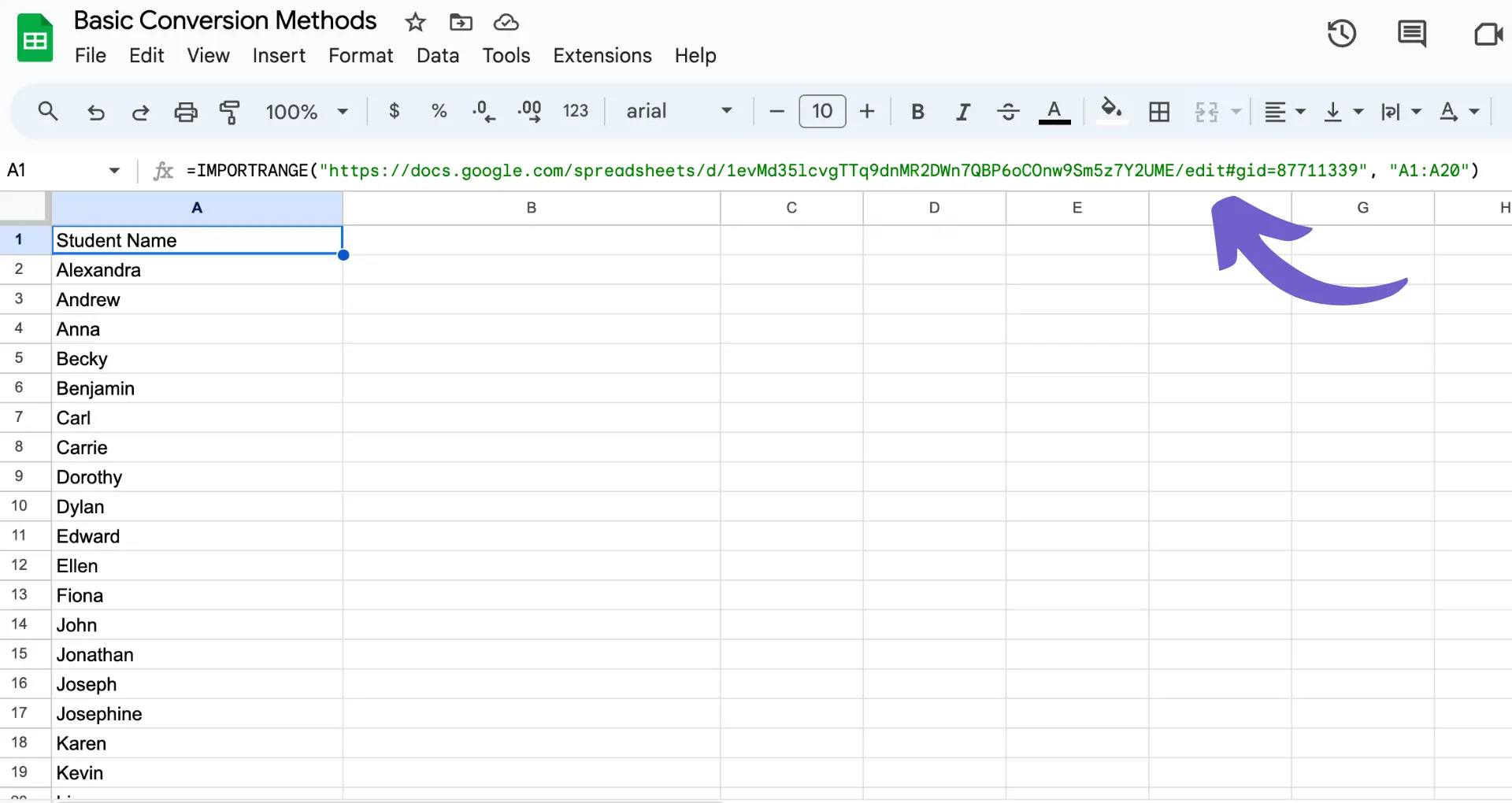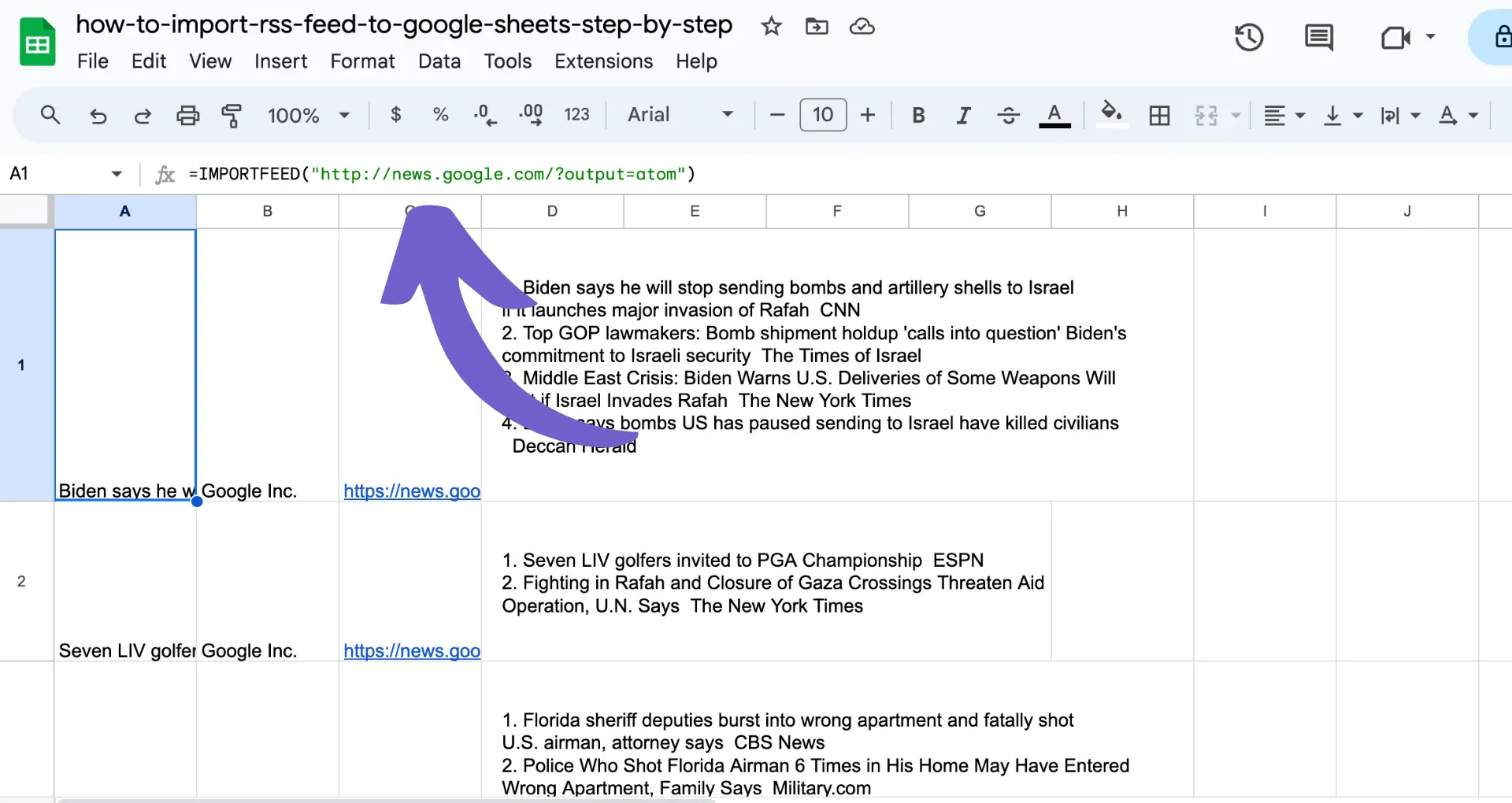





Use IMPORT functions to bring web data into Google Sheets.
By the way, we're Bardeen, we build a free AI Agent for doing repetitive tasks.
If you need to import web data often, try our AI Web Scraper. It automates data extraction directly into Google Sheets, saving you time.
Importing data from websites into Google Sheets is a powerful way to collect, analyze, and share information. Whether you're a business owner, marketer, or data enthusiast, mastering this skill can save you time and effort in managing your data. In this step-by-step guide, we'll walk you through the process of importing data from websites into Google Sheets using built-in functions, third-party tools, and even APIs.
Google Sheets offers several built-in functions that allow you to import data from websites directly into your spreadsheet. These functions include:
To use these functions effectively, it's essential to understand when to apply each one based on the structure of the data you want to import. For example, if you need to import a table from a web page, scraping data from the website could be the most suitable method. On the other hand, if you want to import data from an XML file or a specific element within an HTML page, IMPORTXML would be the best choice.
Let's take a closer look at the syntax for each function:
By understanding these functions and their syntax, you'll be able to effectively import data from various websites into your Google Sheets, saving time and effort in the process. For even more efficiency, consider adding ChatGPT to Google Sheets to automate repetitive tasks.
Before you can start importing data from websites into Google Sheets, it's essential to set up your spreadsheet properly. Here's a step-by-step guide:
Once your sheet is set up, you can start using the IMPORT functions to bring in data from various websites. Here are a few tips to optimize your data import process:
By setting up your Google Sheets properly and following these tips, you'll be well-prepared to import and work with data from websites efficiently and effectively. For more advanced automation, you can enrich LinkedIn profiles directly in your sheets.
Bardeen can help you enrich LinkedIn profiles in Google Sheets. Save time and reduce manual effort with this handy feature.
Google Sheets offers several built-in functions that allow you to import data from websites directly into your spreadsheet. These functions include:


To use these functions effectively, it's essential to understand their syntax and when to apply each one. Here are some examples:
=IMPORTDATA("https://example.com/data.csv") - This imports the contents of a CSV file from the specified URL.=IMPORTHTML("https://en.wikipedia.org/wiki/List_of_countries_by_GDP_(nominal)", "table", 1) - This imports the first table from the specified Wikipedia page.=IMPORTXML("https://www.example.com/data", "//table[1]") - This imports the first table element from the XML document at the given URL.=IMPORTFEED("https://www.example.com/feed") - This imports the RSS or ATOM feed from the specified URL.When deciding which function to use, consider the format of the data you want to import and the structure of the web page or document containing the data. IMPORTDATA works well for simple, tabular data in CSV or TSV format, while IMPORTHTML and IMPORTXML are better suited for extracting data from more complex HTML or XML pages. IMPORTFEED is specifically designed for importing RSS or ATOM feeds.
By mastering these IMPORT functions, you can efficiently pull data from various web sources into your Google Sheets, saving time and effort in manual data entry and enabling more advanced data analysis and reporting. You can also use tools like AI web scraper to automate data extraction tasks.
When using IMPORTXML and IMPORTHTML functions in Google Sheets, you may encounter various errors that prevent data from being imported correctly. Some of the most common issues include:
To troubleshoot these issues, consider the following solutions:
For more efficiency, try using Bardeen to connect Google Docs. It can automate your tasks and imports, saving you time.
By understanding common issues and having a toolkit of troubleshooting techniques, you can minimize disruptions and ensure your Google Sheets imports continue working smoothly.
Google Sheets offers a wide range of third-party tools and add-ons that can significantly extend its data import capabilities, making it easier to work with complex or secure websites. These add-ons can streamline the process of importing data from various sources, ensuring that your Google Sheets remain up-to-date with the latest information.
Some popular Google Sheets add-ons for enhanced data importing include:

These add-ons extend the basic capabilities of Google Sheets in several ways:
By leveraging these third-party tools and add-ons, you can significantly enhance your data importing workflows in Google Sheets, saving time and effort while ensuring that your spreadsheets always contain the most accurate and up-to-date information.
Automating data import to Google Sheets is a powerful way to ensure that your spreadsheets always contain the most up-to-date information without requiring manual intervention. By setting up automatic data refreshes, you can save time and reduce the risk of errors associated with manual data entry.
To automate data import in Google Sheets, you can use built-in features like the IMPORTRANGE function or leverage the power of automation tools for data enrichment for more advanced automation. Here's how you can set up automatic data refreshes:

When using Google Apps Script for advanced automation, you can:
By leveraging the power of Google Apps Script, you can create sophisticated automation workflows that keep your Google Sheets data up-to-date and synchronized with external data sources. This not only saves you time but also ensures that you always have access to accurate and timely information for analysis and decision-making.
Save more time with automating Google Drive tasks. Let Bardeen handle file uploads, updates, and sharing.
Integrating APIs with Google Sheets is a powerful way to import data from websites that offer API access. By leveraging the capabilities of Google Apps Script, you can create custom functions and automate the process of fetching data from APIs and populating your spreadsheets.
To get started, you'll need to familiarize yourself with the basics of Google Apps Script and the specific API you want to integrate with. Here's a step-by-step guide to integrating an API with Google Sheets:

Here's a basic example that demonstrates how to fetch data from an API and import it into Google Sheets using Google Apps Script:
function importDataFromAPI() {
var apiUrl = "https://api.example.com/data";
var response = UrlFetchApp.fetch(apiUrl);
var data = JSON.parse(response.getContentText());
var sheet = SpreadsheetApp.getActiveSheet();
sheet.getRange("A1").setValue(data.value);
}
In this example, the importDataFromAPI() function fetches data from the specified API URL, parses the JSON response, and writes the value to cell A1 of the active sheet.
By leveraging the power of APIs and Google Apps Script, you can create custom functions that automatically import data from various sources, keeping your Google Sheets up-to-date with the latest information. This integration enables you to build powerful and dynamic spreadsheets that can pull data from external systems, databases, or web services, streamlining data management and analysis processes.
Proper data management is essential for maintaining the integrity and security of your information in Google Sheets. Here are some best practices to follow:

By implementing these data management best practices, you'll ensure the accuracy, security, and longevity of your information in Google Sheets, making it easier to build prospect lists and make data-driven decisions.
Bardeen can save you time by automating data validation and cleanup tasks. Try out the automated workflows.









SOC 2 Type II, GDPR and CASA Tier 2 and 3 certified — so you can automate with confidence at any scale.
Bardeen is an automation and workflow platform designed to help GTM teams eliminate manual tasks and streamline processes. It connects and integrates with your favorite tools, enabling you to automate repetitive workflows, manage data across systems, and enhance collaboration.
Bardeen acts as a bridge to enhance and automate workflows. It can reduce your reliance on tools focused on data entry and CRM updating, lead generation and outreach, reporting and analytics, and communication and follow-ups.
Bardeen is ideal for GTM teams across various roles including Sales (SDRs, AEs), Customer Success (CSMs), Revenue Operations, Sales Engineering, and Sales Leadership.
Bardeen integrates broadly with CRMs, communication platforms, lead generation tools, project and task management tools, and customer success tools. These integrations connect workflows and ensure data flows smoothly across systems.
Bardeen supports a wide variety of use cases across different teams, such as:
Sales: Automating lead discovery, enrichment and outreach sequences. Tracking account activity and nurturing target accounts.
Customer Success: Preparing for customer meetings, analyzing engagement metrics, and managing renewals.
Revenue Operations: Monitoring lead status, ensuring data accuracy, and generating detailed activity summaries.
Sales Leadership: Creating competitive analysis reports, monitoring pipeline health, and generating daily/weekly team performance summaries.
